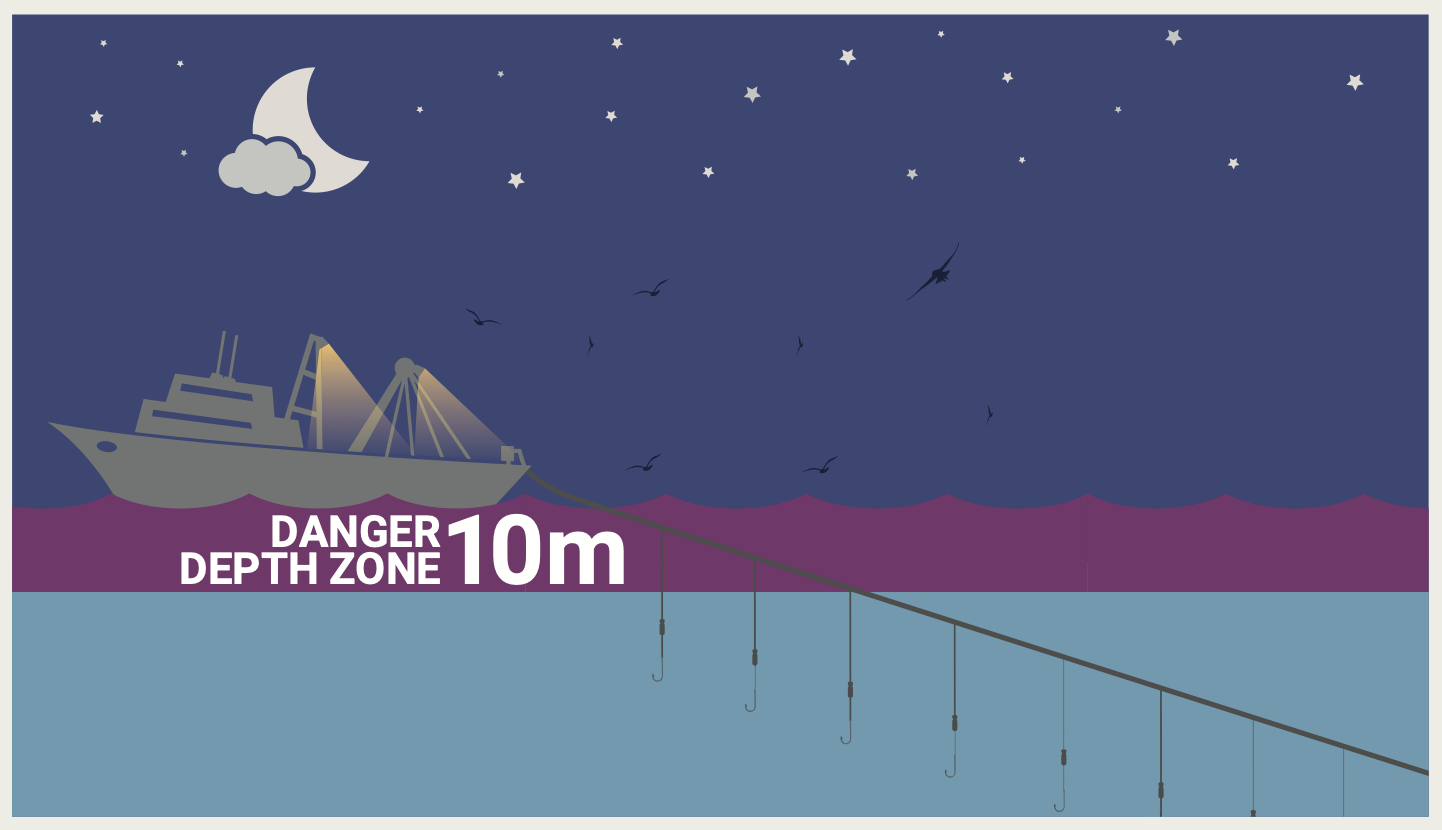 An image from ACAP's Night-setting Factsheet - available to download at the ACAP website under Resources. According to the research undertaken by The Navigators, fishers agreed that setting at night was an effective seabird bycatch mitigation measure
An image from ACAP's Night-setting Factsheet - available to download at the ACAP website under Resources. According to the research undertaken by The Navigators, fishers agreed that setting at night was an effective seabird bycatch mitigation measure
New Zealand social research agency, The Navigators, have prepared a report for the Department of Conservation’s Conservation Services Program. The research analyses the barriers and drivers for fishers to implement seabird bycatch mitigation measures in New Zealand’s small vessel bottom longline fisheries.
The report’s Executive Summary follows:
“Commercial fishers are expected to meet the seabird mitigation standards under the New Zealand Government’s National Plan of Action — Seabirds 2020 (NPOA 2020). Objective one of the NPOA 2020 is to “ensure all New Zealand commercial fishers are using practices that best avoid the risk of seabird bycatch, enabled by appropriate regulations”. These practices referred to are outlined in the 2021 legislative requirements as well as the 2019 mitigation standards, and are supported via collaborative industry approaches including the Department of Conservation’s (DOC) liaison programme.
In the past, DOC has mostly focused on technical solutions and support to help fishers mitigate seabird bycatch. To help supplement their work, DOC identified the need for a deeper understanding of fishers’ drivers and barriers to seabird bycatch mitigation uptake using a social science research approach.
To undertake the research, The Navigators (an independent social research agency) were commissioned to seek feedback from fishers in New Zealand’s inshore small vessel bottom longline commercial fleet. The Navigators conducted 18 in-depth interviews with skippers, owner-operators and owners, representing two-thirds of the fishing effort across the fleet. The research found that fishers are driven to avoid seabird captures, with the key drivers being their respect for seabirds, government interventions (e.g. outreach support, industry education, and compliance monitoring and enforcement), protection of themselves, their crew and industry, and productivity and commercial demand interests.
The research also found fishers have a broad range of motivational and capability barriers to implementing the mitigation standards. Two of the core motivational barriers were:
- fishers were not personally catching any or very few seabirds per year; and
- fishers didn’t understand why it’s necessary to mitigate against seabird captures at times when seabirds are not present.
In addition to the above motivational barriers, bluenose and hāpuka fishers had significant capability barriers in being able to meet the tori line and line weighting regulations. There are also a broad range of other barriers specific to the each of the mitigation standards. The recommendations from this research list a broad range of opportunities to improve seabird mitigation in the fishery and/or to get fishers to consistently follow the mitigation standards. The recommendations are grouped under four topic areas to address each of the following:
- achievability and safety barriers: These barriers are in most need of attention from a fishers’ point of view and ideally need to be addressed before cameras come onboard. They mostly relate to bluenose and hāpuka fishing, solo fishing, as well as the use of tori lines and hauling mitigation.
- motivational barriers: These barriers must be resolved if fishers are going to willingly do more than they are currently. They mostly relate to fishers’ experience in regard to not catching seabirds, their low versus high risk scenarios, and technical issues regarding tangles, weighting, and sink rate tests.
- information, clarity and direction: The recommendations in this section relate to suggested areas of improvement to help fishers better understand what is expected of them as well as to help increase their knowledge (e.g. through knowledge sharing).
- sense of fairness and robustness: These recommendations in this section relate to fishers’ understanding and the measurement of seabird capture statistics, as well as how fishers are perceived by the public and NGOs.
Reference:
Turner, P. 2023. Understanding drivers and barriers to seabird bycatch mitigation uptake in small vessel bottom longline fisheries. MIT2022-02 final report prepared by The Navigators Ltd for the Department of Conservation. 123 p.
18 October 2023

 English
English  Français
Français  Español
Español